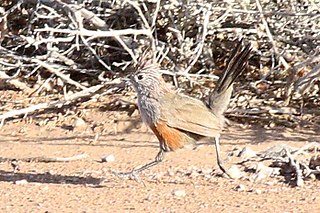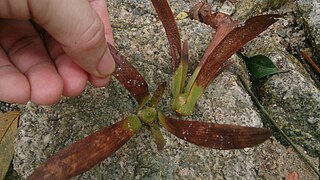
The lanceolated warbler is an Old World warbler in the grass warbler genus Locustella. It breeds from northeast European Russia across the Palearctic to northern Hokkaidō, Japan. It is migratory, wintering in Southeast Asia. The genus name Locustella is from Latin and is a diminutive of locusta, "grasshopper". This refers to the song of the common grasshopper warbler and some others in this genus. The specific lanceolata is Latin for "spear-shaped" and refers to the streaks on the breast.
Crudia lanceolata is a species of plant in the family Fabaceae. It is a tree found in Peninsular Malaysia and Thailand. It is threatened by habitat loss.
Imbralyx incredibilis, synonym Fordia incredibilis, is a species of legume in the family Fabaceae. It is a tree endemic to Peninsular Malaysia. It is threatened by habitat loss.
Fordia is a genus of flowering plant in the family Fabaceae, native from south China and Thailand to west and central Malesia. The genus was established by William Hemsley in 1886.
Fordia ophirensis is a species of legume in the family Fabaceae. It is endemic to Peninsular Malaysia. It is threatened by habitat loss.
Fordia pauciflora is a species of legume in the family Fabaceae. It is a tree found in Peninsular Malaysia and Thailand. It is threatened by habitat loss.
Lecythis lanceolata is a species of woody plant in the family Lecythidaceae of the order Ericales. It is endemic to the Atlantic Forest ecoregion in southeast Brazil, where is known as sapucaia-mirim. It was described by Jean Louis Marie Poiret in 1804.
Kokia lanceolata, the Wailupe Valley treecotton, was a species of flowering plant in the family Malvaceae. It was the only species of Kokia to occur on the island of Oahu and originally known from the hills of Makapu'u, Koko Head and Wailupe Valley. It became extinct not long after its discovery in the 1880s, most likely due to grazing pressure from cattle and goat ranching.
Dypsis lanceolata is a species of flowering plant in the family Arecaceae. It is found only in Comoros.

The crested gallito is a species of bird in the family Rhinocryptidae. It is found in Argentina, Bolivia, and Paraguay.
Buchanania lanceolata is a species of plant in the family Anacardiaceae. It is endemic to India.
Gluta lanceolata is a species of plant in the family Anacardiaceae. It is a tree endemic to Peninsular Malaysia.
Heliciopsis lanceolata is a species of plant in the family Proteaceae. It is found in Indonesia and Malaysia. It is threatened by habitat loss.

Kageneckia lanceolata is a species of plant in the family Rosaceae. It is found in Bolivia and Peru. It is threatened by habitat loss.
Meryta lanceolata is a species of plant in the family Araliaceae. It is endemic to French Polynesia.

Protea lanceolata is a species of plant in the family Proteaceae. It is endemic to the Cape Provinces of South Africa. It is threatened by habitat loss.
Saurauia lanceolata is a species of plant in the Actinidiaceae family. It is endemic to Java in Indonesia.
Wrightia lanceolata is a species of plant in the family Apocynaceae. It is endemic to Thailand.

Dryobalanops lanceolata is a species of plant in the family Dipterocarpaceae. The species name is derived from Latin and refers to the shape of the leaf. This species is endemic to Borneo. It is common in protected areas, although elsewhere it has suffered modest population decline due to logging and land conversion.

Sterculia lanceolata is a tree species, belonging to the genus Sterculia and the family Malvaceae. The species can be found in southern China and Vietnam.






